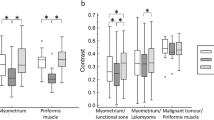Abstract
The present study sought to provide optimized radiographic information regarding endometrial cancer by comparing dynamic contrast-enhanced images obtained using the 3-dimensional T 1-weighted high-resolution isotropic volume examination (3D-THRIVE) technique to existing 2-dimensional magnetic resonance (MR) images to provide data regarding the radiological advantages and the technical aspects of 3D-THRIVE. This study included 30 patients with suspected endometrial cancer who were referred for an MR exam for disease characterization and staging. A 3.0T MR scanner was used to obtain 2D turbo spin echo (2D-TSE) images prior to injection of the contrast medium. After the injection, 3D-THRIVE images and 2D spectral pre-saturation inversion recovery (2D-SPIR) images were obtained. The imaging methods were quantitatively compared using the signal-to-noise ratios (SNRs) of the uterus and the endometrial cancer, the contrast-to-noise ratio (CNR) between tissue pairs, and the time-intensity curve. Comparative qualitative analyses were also conducted using an MR image evaluation tool. Comparison of the pre- and post-contrast enhancement images showed that the SNRs measured from the uterus and the endometrial cancer (SNR uterus and SN R ec ) were relatively higher and more optimized for the contrast-enhanced 3D-THRIVE and 2D-SPIR images than they were for the pre-contrast 2D-TSE images (p < 0.05). Comparison of the images after contrast enhancement showed that the SNR ec value was higher for the 2D-SPIR image than for the 3D-THRIVE image. The CNR ec/uterus value was higher for the 3D-THRIVE image than for the 2D-SPIR image (p > 0.05). The time-intensity curve was obtained with the 3D-THRIVE sequence and provided data that enabled a differentiation between malignant tumors and normal tissue. The overall image quality, artifacts, and lesion definition and representation were superior for contrast-enhanced 3D-THRIVE images compared to pre- and post-contrast enhancement of 2D-TSE and 2D-SPIR images (p < 0.05). In conclusion, 3D-THRIVE images had better image quality than 2D-TSE and SPIR images. In addition to 3D-THRIVE being an alternative to 2D-TSE and SPIR in terms of endometrial cancer characterization and staging, it also provides superior data for the differentiation between malignant tumors and normal tissue.
Similar content being viewed by others
References
Y. R. Shin and S. E. Rha, J. Korean Soc. Magn. Reson. Med. 14, 1 (2010).
F. Amant, P. Moerman, P. Neven, D. Timmerman, E. Van Limbergen and I. Vergote, Lancet 366, 491 (2005).
W. T. Creasman, F. Odicino, P. Maisonneuve, M. A. Quinn, U. Beller, J. L. Benedet, A. P. Heintz, H. Y. Ngan and S. Pecorelli, Int. J. Gynaecol. Obstet. 95, S105 (2006).
K. A. Frei, K. Kinkel, H. M. Bonél, Y. Lu, C. Zaloudek and H. Hricak, Radiology 246, 444 (2000).
K. Kinkel, R. Forstner, F. M. Danza, L. Oleaga, T. M. Cunha, A. Bergman, J. O. Barentsz, C. Balleyguier, B. Brkljacic and J. A. Spencer, Eur. Radiol. 19, 1565 (2009).
I. S. Haldorsen and H. B. Salvesen, Clin. Radiol. 67, 2 (2012).
N. M. Rofsky, V. S. Lee, G. Laub, M. A. Pollack, G. A. Krinsky, D. Thomasson, M. M. Ambrosino and J. C. Weinreb, Radiology 212, 876 (1999).
C. Lavini, J. J. Verhoeff, C. B. Majoie, L. J. Stalpers, D. J. Richel and M. Maas, J. Magn. Reson. Imaging 34, 1303 (2011).
W. T. Creasman, C. P. Morrow, B. N. Bundy, H. D. Homesley, J. E. Graham and P. B. Heller, Cancer 60, 2035 (1987).
E. Charneco, A. P. Ortiz, H. L. Venegas-Ríos, J. Romaguera and S. Umpierre, P. R. Health Sci. J. 29, 272 (2010).
H. D. Homesley, Clin. Obstet. Gynecol. 35, 89 (1992).
T. M. Cunha, A. Félix and I. Cabral, Int. J. Gynecol. Cancer 11, 130 (2001).
Y. T. Jeon, K. R. Hwang, J. W. Kim, N. H. Park, Y. S. Song, S. B. Kang and H. P. Lee, Korean J. Obstet. Gynecol. 44, 1650 (2001).
B. Turkbey, P. A. Pinto, H. Mani, M. Bernardo, Y. Pang, Y. L. McKinney, K. Khurana, G. C. Ravizzini, P. S. Albert, M. J. Merino and P. L. Choyke, Radiology 255, 89 (2010).
Author information
Authors and Affiliations
Corresponding author
Rights and permissions
About this article
Cite this article
Lee, JS., Im, IC., Goo, EH. et al. Contrast-enhanced three-dimensional MR imaging using T 1-weighted high-resolution isotropic volume examination (THRIVE): Focus on endometrial cancer. Journal of the Korean Physical Society 63, 89–96 (2013). https://doi.org/10.3938/jkps.63.89
Received:
Accepted:
Published:
Issue Date:
DOI: https://doi.org/10.3938/jkps.63.89




